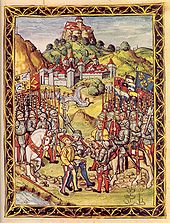Treason of Novara
The betrayal of Novara is an event that occurred in 1500 in connection with the conflict over rule over Italy.


Starting position
Towards the end of the 15th century, alongside the Papal States and the Republic of Venice, the Kingdom of Naples and the Duchy of Milan were of political importance. King Charles VIII of France asserted hereditary claims on Naples and conquered the kingdom in 1495, but became through the covenant between Pope Alexander VI. , the Roman-German King Maximilian I , Ferdinand II of Naples and others expelled from Italy again (see: Italian Wars ).
Conflict between France and Milan
After Karl's death in 1498, his successor King Louis XII conquered . With the help of around 5000 federal mercenaries, in the autumn of 1499 the Duchy of Milan, to which he raised claims as the grandson of the Milanese Princess Valentina Visconti . In the spring of 1500, the Duke of Milan, Ludovico Sforza ("Il moro"), recaptured his duchy with the help of around 5000 federal mercenaries.
At Novara , the Milanese and French armies finally faced each other, both reinforced by federal troops: the approximately 6,000 Swiss Moros defended the city, the 10,000 Swiss Louis XII. besieged them.
The Federal Diet tried to mediate and prevent paid confederates from fighting each other and brothers fighting brothers and fathers against sons . Louis XII. finally agreed to a free withdrawal of the Swiss, but Ludovico Sforza should be extradited. However, the Swiss decided to disguise the duke as a mercenary and lead him out of the city in their own ranks.
Betrayal of Sforza
When marching out of the city on April 10, 1500, the withdrawing mercenaries had to pass the alley of the besieging Confederates. Below were French captains who controlled the withdrawal. When Ludovico Sforza walked by, he was betrayed by a sign from the soldier Hans (also Rudolf) Turmann from the canton of Uri . The duke was taken from the ranks and led away. He died eight years later in a prison in Loches Castle in the Loire Valley .
The governor (bailly) of Dijon gave Turmann two hundred crowns for breaching his loyalty, which was five times the annual salary of a mercenary. He stayed in France first, and when he believed the matter had grown, he returned to Uri after three years. However, he was immediately arrested and charged. The very next day he was beheaded in the Schächenwald above Altdorf . According to other sources ( HLS ), Turmann was executed as early as 1501.
Literary processing
- Caesar of Arx : The betrayal of Novara. Play in three acts. Sauerlander, Aarau 1934.
- Alex Capus : The betrayal of Novara. In: Alex Capus: 13 true stories. Deuticke, Vienna et al. 2004, ISBN 3-216-30738-7 .
literature
- Peter Dürrenmatt : Swiss History. 2 volumes. Swiss publishing house, Zurich 1976, ISBN 3-7263-6165-0 .
- Ernst Gagliardi : The share of the Swiss in the Italian wars 1494-1516. Volume 1: From Charles VIII's train to Naples to the League of Cambrai 1494–1509. Schulthess, Zurich 1919.
- Benno Kindt: The Ludovico Moros disaster in Novara in April 1500. A source-critical investigation. Greifswald 1890, (Greifswald, University, dissertation, 1890; digitized version ).
- Johann Conrad Vögelin: History of the Swiss Confederation. Volume 2. Geßnersche Buchhandlung, Zurich 1822, p. 244 f.
- Salomon von Orelli: Aloysius von Orelli. A biographical attempt. Ziegler, Zurich 1797, p. 48 .
Web links
- Hans Stadler: Battles near Novara. In: Historical Lexicon of Switzerland .